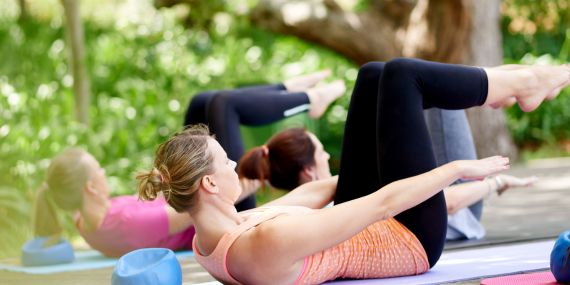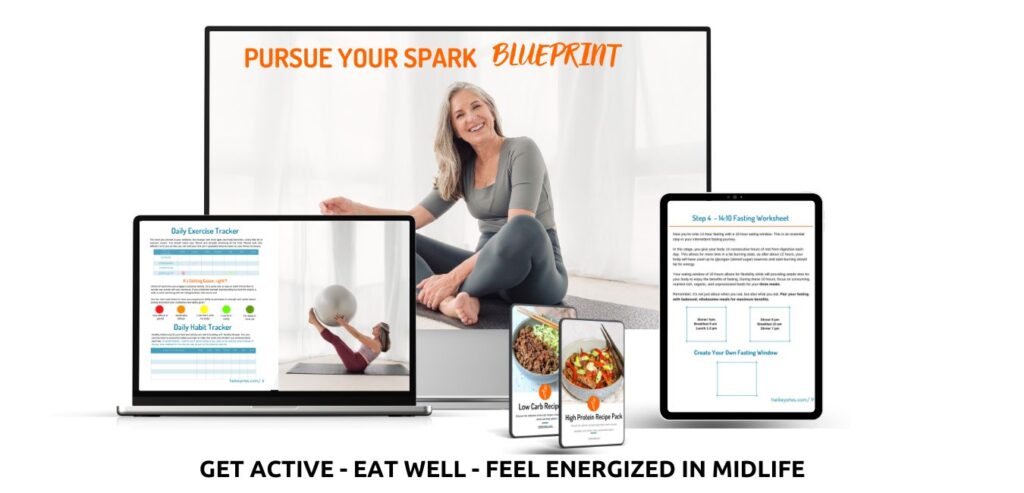You’ve just been diagnosed with osteoporosis, and panic sets in. It’s natural; that word hits hard. But let’s pause and redirect that energy. This episode isn’t about dwelling in worry; it’s your action guide. We’re shifting from the shock of diagnosis to the power of prevention. Starting now, it’s all about arming yourself with the right nutrition, the best exercises, and the smartest lifestyle choices. Osteoporosis is serious, but what is your response to it? That’s where your real power lies. Let’s tackle this together, making decisions today that you’ll thank yourself for tomorrow. Welcome to your action plan to fight osteoporosis by starting with the 5″Essential Bone Health Strategies in Midlife.”
A compelling statistic from the National Osteoporosis Foundation states that “one in two women over the age of 50 will break a bone due to osteoporosis.” Many people with osteoporosis don’t know they have it until they break a bone. Screening is essential to identify these people before this happens so they can take steps to decrease the effects of osteoporosis.
In the United States, the general recommendation is that women start osteoporosis screening at age 65. However, for those at increased risk of osteoporosis—due to factors like early menopause, a family history of the disease, certain medical conditions, or the use of medications that can weaken bones—screening may begin earlier.

What is Osteoporosis?
Osteoporosis occurs when bones become less dense and more likely to fracture. Fractures are not uncommon as we age, but bone loss can also result in loss of height, severe back pain, and a change in posture. It can affect how we walk and can result in permanent disability. Osteoporosis is known as the silent killer as it can progress undetected without any symptoms.
Risk factors for developing Osteoporosis include:
- Thinness or small frame.
- Family history of the disease.
- Being postmenopausal and particularly having had early menopause.
- Abnormal absence of menstrual periods (amenorrhea).
- Prolonged use of certain medications, such as those used to treat lupus, asthma, thyroid deficiencies, and seizures.
- Low calcium intake.
- Lack of physical activity.
- Smoking decreases the absorption of calcium from the diet.
- Excessive alcohol intake.
Myths vs. Facts of Osteoporosis and Bone Health
There’s a lot of confusion out there, and it’s time we cleared it up with straight facts. Understanding what’s true and what’s not can make all the difference in how we protect our bones, especially in midlife.

Today, we’re zeroing in on five myths to debunk them once and for all, making sure you have the accurate information you need to take charge of your bone health.
Here are five myths and facts:
- Myth: Osteoporosis is a natural part of aging that cannot be avoided. Fact: While age is a risk factor, lifestyle choices such as diet, exercise, and preventative measures can significantly reduce the risk and impact of osteoporosis.
- Myth: Only women get osteoporosis. Fact: Osteoporosis can affect anyone, regardless of gender. While it’s more common in women, especially post-menopause, men also face a significant risk as they age.
- Myth: You can’t build bone density after menopause. Fact: Even after menopause, activities like strength training and weight-bearing exercises, along with adequate nutrition, can help maintain and even improve bone density.
- Myth: If you have osteoporosis, you should avoid exercise to prevent fractures. Fact: Regular, safe exercise is crucial for strengthening bones and muscles, improving balance, and reducing the risk of falls and fractures. It’s about choosing the right type and intensity of activity.
- Myth: Calcium alone is enough to protect against osteoporosis. Fact: Calcium is important, but vitamin D, magnesium, and other nutrients play critical roles in bone health.
Resource: 5 Ways to Prevent Osteoporosis over 50

Mindset Shift to Redefining Bone Health in Midlife
Shifting our mindset about bone health, especially after a diagnosis like osteoporosis, is crucial. Yes, hearing “osteoporosis” can be frightening. It’s normal to feel concerned—it’s a sign that you care deeply about your health and quality of life. But here’s the key: while osteoporosis is serious, it’s not a signal to give up. It’s a call to action.
Acknowledging the fear and concern is the first step. The next step? Realizing that so much is in our hands. This isn’t just about what’s happening to our bones; it’s about what we can do to support and strengthen them. Our daily choices—what we eat, move, and lifestyle habits—have power. They’re our tools to fight back, build stronger bones, and maintain our health and independence.
A positive mindset here doesn’t mean ignoring the realities or brushing off the diagnosis. Instead, it’s about facing the situation head-on with a determination to make changes that count. It’s about seeing beyond the diagnosis to the opportunities it presents for taking charge of our health. We can manage osteoporosis effectively with the correct information, support, and actions. Let’s focus on what we can control, take proactive steps, and remember our health journey is ours to shape.
Ask your doctor about the level of bone loss and get a DEXA scan so that you can make an educated decision supported by your medical team.
5 Essential Osteoporosis Strategies In Midlife
When the overload of osteoporosis advice starts swirling around, it’s easy to feel lost. But remember, taking control back begins with one simple step. It could be choosing water over wine tonight or going for a walk instead of watching TV. These small choices add up, cutting through the noise and leading you toward a path of stronger bones.

The best Osteoporosis exercises focus on building and maintaining bone density and improving balance and muscle strength to reduce the risk of falls and fractures.
- Weight-bearing exercises: Your body works against gravity, stimulating bone formation and helping maintain bone density. Examples are walking, jogging, hiking, dancing, climbing stairs, or jumping rope.
- Resistance training: Strength-training exercises help build muscle mass and strengthen the bones. Use free weights, resistance bands, body weights, or weight machines in the gym. Squats, lunges, push-ups, and upper and lower body exercises. Target all muscle groups – especially the back, to promote a strong spine. Pilates has been shown to increase bone mineral density in the spine.
- Balance exercises: Better balance can reduce the risk of falls, which is particularly important for osteoporosis. Balance exercises include standing on one leg, yoga, Thai Chi, and standing Pilates.
- Flexibility exercises: Maintaining flexibility helps improve overall mobility and reduce the risk of injury. Pilates and other forms of gentle stretching are good examples.
- Nutrition Overhaul: To support bone density, emphasize a diet rich in calcium, vitamin D, and magnesium. Think leafy greens, dairy (or fortified alternatives), nuts, and seeds. Remember, foods high in omega-3s and lean protein are good for overall health and inflammation reduction.
Resource: The Best Osteoporosis Exercises: Pilates Strategies to Crush Osteoporosis
Podcast: #5 Pilates To Crush Osteoporosis (from our limited Pilates podcast series
Aim for at least 30 minutes of physical activity most days of the week. Avoid prolonged sitting and spread movements out during the day. Swimming, as good as it is for the body, does not qualify as a weight-bearing exercise.
The 5 Benefits of Pilates To Strengthen Your Bones

Learn about the transformative power of Pilates and the top 5 benefits it offers for better bone health strategies and overall well-being:
- Improved muscle strength: Pilates exercises can help increase muscle strength, particularly in the core, back, and pelvic muscles. This improved strength can provide better support for the spine and enhance overall stability.
- Better balance and coordination: Pilates exercises often emphasize balance and coordination, which can help reduce the risk of falls.
- Enhanced posture: Pilates can improve posture by strengthening the muscles that maintain proper spinal alignment. Good posture can help minimize stress on the spine and reduce the risk of vertebral fractures.
- Increased flexibility: Pilates exercises promote flexibility, improving overall mobility and decreasing the risk of injury.
- Mind-body awareness: Pilates encourages a strong mind-body connection, which can help increase body awareness and promote healthier movement patterns. When exercising, focus on slow, controlled movements.
Redefining Bone Health In Midlife
So here’s your actionable step: Choose one thing you can do today to improve your bone health. Maybe it’s adding calcium-rich foods to your diet, going for a brisk walk, looking into a Pilates class, or even setting up a chat with your doctor about bone health. It’s time to put those bone health strategies into action!
Remember, your mindset is your greatest ally. With a positive outlook and proactive steps, there’s no limit to the healthy, fit lifestyle you can enjoy and thrive with osteoporosis. Let’s not view it as a full stop but as a comma, a pause that allows us to recalibrate.
I would love to hear how this episode resonates with you. Email heike@heikeyates.com, but put “BONE” in the subject line. Share your story or ask questions. I’m here for you.
Ready to embrace your wellness transformation? ✨ One call, one action step, and a whole new direction. Make sure to book your 20-minute Spark Breakthrough Call by clicking the link right here today. Don’t delay; your journey to better health and fitness starts now. Let’s do this together!
